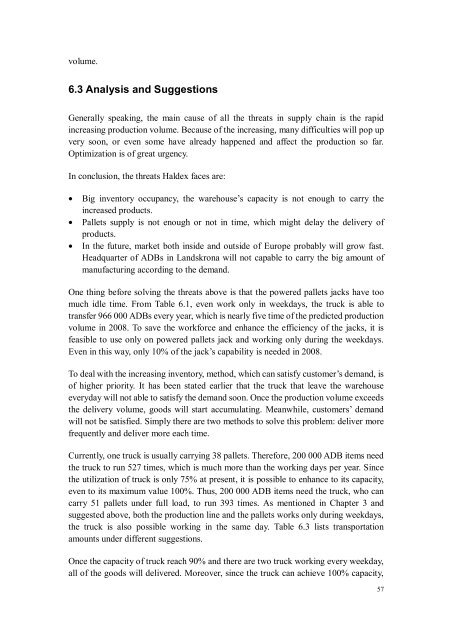Improvement of Material Flow in the Production and Supply Chain of ...
Improvement of Material Flow in the Production and Supply Chain of ...
Improvement of Material Flow in the Production and Supply Chain of ...
Create successful ePaper yourself
Turn your PDF publications into a flip-book with our unique Google optimized e-Paper software.
volume.<br />
6.3 Analysis <strong>and</strong> Suggestions<br />
Generally speak<strong>in</strong>g, <strong>the</strong> ma<strong>in</strong> cause <strong>of</strong> all <strong>the</strong> threats <strong>in</strong> supply cha<strong>in</strong> is <strong>the</strong> rapid<br />
<strong>in</strong>creas<strong>in</strong>g production volume. Because <strong>of</strong> <strong>the</strong> <strong>in</strong>creas<strong>in</strong>g, many difficulties will pop up<br />
very soon, or even some have already happened <strong>and</strong> affect <strong>the</strong> production so far.<br />
Optimization is <strong>of</strong> great urgency.<br />
In conclusion, <strong>the</strong> threats Haldex faces are:<br />
• Big <strong>in</strong>ventory occupancy, <strong>the</strong> warehouse’s capacity is not enough to carry <strong>the</strong><br />
<strong>in</strong>creased products.<br />
• Pallets supply is not enough or not <strong>in</strong> time, which might delay <strong>the</strong> delivery <strong>of</strong><br />
products.<br />
• In <strong>the</strong> future, market both <strong>in</strong>side <strong>and</strong> outside <strong>of</strong> Europe probably will grow fast.<br />
Headquarter <strong>of</strong> ADBs <strong>in</strong> L<strong>and</strong>skrona will not capable to carry <strong>the</strong> big amount <strong>of</strong><br />
manufactur<strong>in</strong>g accord<strong>in</strong>g to <strong>the</strong> dem<strong>and</strong>.<br />
One th<strong>in</strong>g before solv<strong>in</strong>g <strong>the</strong> threats above is that <strong>the</strong> powered pallets jacks have too<br />
much idle time. From Table 6.1, even work only <strong>in</strong> weekdays, <strong>the</strong> truck is able to<br />
transfer 966 000 ADBs every year, which is nearly five time <strong>of</strong> <strong>the</strong> predicted production<br />
volume <strong>in</strong> 2008. To save <strong>the</strong> workforce <strong>and</strong> enhance <strong>the</strong> efficiency <strong>of</strong> <strong>the</strong> jacks, it is<br />
feasible to use only on powered pallets jack <strong>and</strong> work<strong>in</strong>g only dur<strong>in</strong>g <strong>the</strong> weekdays.<br />
Even <strong>in</strong> this way, only 10% <strong>of</strong> <strong>the</strong> jack’s capability is needed <strong>in</strong> 2008.<br />
To deal with <strong>the</strong> <strong>in</strong>creas<strong>in</strong>g <strong>in</strong>ventory, method, which can satisfy customer’s dem<strong>and</strong>, is<br />
<strong>of</strong> higher priority. It has been stated earlier that <strong>the</strong> truck that leave <strong>the</strong> warehouse<br />
everyday will not able to satisfy <strong>the</strong> dem<strong>and</strong> soon. Once <strong>the</strong> production volume exceeds<br />
<strong>the</strong> delivery volume, goods will start accumulat<strong>in</strong>g. Meanwhile, customers’ dem<strong>and</strong><br />
will not be satisfied. Simply <strong>the</strong>re are two methods to solve this problem: deliver more<br />
frequently <strong>and</strong> deliver more each time.<br />
Currently, one truck is usually carry<strong>in</strong>g 38 pallets. Therefore, 200 000 ADB items need<br />
<strong>the</strong> truck to run 527 times, which is much more than <strong>the</strong> work<strong>in</strong>g days per year. S<strong>in</strong>ce<br />
<strong>the</strong> utilization <strong>of</strong> truck is only 75% at present, it is possible to enhance to its capacity,<br />
even to its maximum value 100%. Thus, 200 000 ADB items need <strong>the</strong> truck, who can<br />
carry 51 pallets under full load, to run 393 times. As mentioned <strong>in</strong> Chapter 3 <strong>and</strong><br />
suggested above, both <strong>the</strong> production l<strong>in</strong>e <strong>and</strong> <strong>the</strong> pallets works only dur<strong>in</strong>g weekdays,<br />
<strong>the</strong> truck is also possible work<strong>in</strong>g <strong>in</strong> <strong>the</strong> same day. Table 6.3 lists transportation<br />
amounts under different suggestions.<br />
Once <strong>the</strong> capacity <strong>of</strong> truck reach 90% <strong>and</strong> <strong>the</strong>re are two truck work<strong>in</strong>g every weekday,<br />
all <strong>of</strong> <strong>the</strong> goods will delivered. Moreover, s<strong>in</strong>ce <strong>the</strong> truck can achieve 100% capacity,<br />
57

















